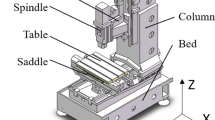Abstract
The vibration of machine tools during machining adversely affects machining accuracy and tool life, and therefore must be minimized. The cutting forces for stable turning are generally known to be random, and hence excite all the resonance modes. Of all these modes, those that generate relative motions between a cutting tool and a workpiece are of concern.
This paper presents a new approach for designing an optimal damper to minimize the relative vibration between the cutting tool and workpiece during stable machining. An approximate normal mode method is employed to calculate the response of a machine tool system with nonproportional damping subject to random excitation. The major advantage of this method is that it reduces the amount of computation greatly for higher-order systems when responses have to be calculated repeatedly in the process of optimization. An optimal design procedure is presented based on a representative lumped parameter model that can be constructed by using existing experimental or analytical techniques. The two-step optimization procedure based on the modified pattern search and univariate search effectively leads the numerical solution to the global minimun irrespectively of initial values even under the existence of many local minima.
Similar content being viewed by others
References
Cowley, A. (1972) Co-operative work in computer aided design in the CIRP. Ann. CIRP 21(2), 257–266
Reddy, V.R.; Sharan, A.M. (1987) The static and dynamic analysis of machine tools using dynamic matrix reduction technique. Int. J. Mach. Tools Manuf. 27(1), 105–112
Haranath, S.; Ganesan, N.; Rao, B.V.A. (1987) Dynamic analysis of machine tool structures with applied damping treatment. Int. J. Mach. Tools Manuf. 27(1), 43–55
Murty, J.R.; Reddy, G.C. (1979) Optimization of functional properties of machine tool structures—A finite element analysis. In: Proceedings of the 20th MTDR Conference, pp. 435–442
Opitz, H.; Noppen, N. (1972) A finite element program system and its application for machine tool structural analysis. In: Proceedings 13th MTDR Conference, pp. 55–60
Shin, Y.C.; Eman, K.F. (1989) A unified approach to the inprocess identification of the closed loop machining dynamics in turning. Trans. NAMRI, SME (May), 235–242
Sata et al. (1973) Learning and recognition of the cutting states by the spectrum analysis. Ann. CIRP 22(1), 41–42
Yuan, J.X.; Wu, S.M. (1985) Identification of the joint structural parameters of machine tool by DDS and FEM. Trans. ASME, J Eng. Ind. 107, 64–69
Shin, Y.C.; Eman, K.F.; Wu, S.M. (1989) Experimental complex modal analysis of machine tool structures. Trans. ASME, J. Eng. Ind. 111 (May), 116–124
Foss, K.A. (1958) Co-ordinates which uncouple the equations of motion of damped linear dynamic systems. J. Appl. Mech. (September), 361–364
Seireg, A.; Howard, L. (1967) An approximate normal mode method for damped lumped parameter systems. Trans. ASME, J. Eng. Ind. (November), 597–604
Crandall S.H.; Mark, W.D. (1963)Random Vibration in Mechanical System. New York: Academic Press
Tlusty, J.; Moriwaki, T. (1976) Experimental and computational identification of dynamic structure models. Ann. CIRP 25, 497–503
Tlusty, J.; Ismail, F. (1980) Dynamic structural identification tasks and methods. Ann. CIRP 29(1), 251–255
Renay, J.P. (1968) Identification of complex structures using near-resonance testing. Shock Vibr. Bull. 38(Part 2), 23–32
Cooper, L.; Steinberg, D. (1970)Introduction to Methods of Optimization, Philadelphia, PA: W.B. Saunders
Author information
Authors and Affiliations
Rights and permissions
About this article
Cite this article
Shin, Y.C., Wang, K.W. Design of an optimal damper to minimize the vibration of machine tool structures subject to random excitation. Engineering with Computers 7, 199–208 (1991). https://doi.org/10.1007/BF01206362
Issue Date:
DOI: https://doi.org/10.1007/BF01206362




